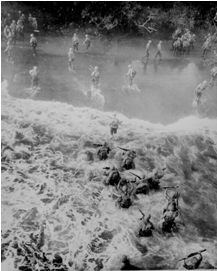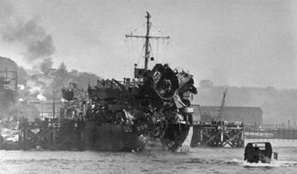Brightwood Boys, The History of the Men from
the North End of
Springfield, Massachusetts,
During World War II
by Christopher P. Montagna
CHAPTER 13
Battle OF Cape Gloucester
“The Green Inferno”
 On December 26, 1943, Nino Montagna and the men of the 1st Marine Division waded ashore from beached LSTs passing through heavy surf to a narrow beach of black sand onto the island of Cape Gloucester. Nino found himself in a dense canopy of foliage that created a perpetual twilight up to twenty feet high. The constant humid climate produced temperatures in the 90’s and the men were constantly pelted with heavy rains of the monsoon season.
On December 26, 1943, Nino Montagna and the men of the 1st Marine Division waded ashore from beached LSTs passing through heavy surf to a narrow beach of black sand onto the island of Cape Gloucester. Nino found himself in a dense canopy of foliage that created a perpetual twilight up to twenty feet high. The constant humid climate produced temperatures in the 90’s and the men were constantly pelted with heavy rains of the monsoon season.
During the Battle of Cape Gloucester, Nino Montagna and the Seabees from the 17th Marine Engineer Battalion built a corduroy road through the damp flatlands behind the landing beaches so that tanks could move forward to punch through the Japanese defenses.
As the Marines advanced across Cape Gloucester, the dense jungle environment and monsoon rains prevented their tanks from providing critical armored offensive power. At one point, the 17th Marine Engineers were called upon to complete a road that enabled Sherman tanks to engage the enemy. As the tanks advanced through the jungle, they reached the banks of a creek. However, the banks of the creek where  too steep for the tanks to travel. The engineers brought forth a bulldozer to level the embankment. While the engineers were undertaking this task, the Japanese opened fire on the engineers. Despite the enemy fire, the engineers continued to work on the embankment. As night fell, the engineers completed the task of converting the embankment into a passable ramp for the tanks and their support troops. Nino Montagna would remain on Cape Gloucester until the island was secured in April 1944.
too steep for the tanks to travel. The engineers brought forth a bulldozer to level the embankment. While the engineers were undertaking this task, the Japanese opened fire on the engineers. Despite the enemy fire, the engineers continued to work on the embankment. As night fell, the engineers completed the task of converting the embankment into a passable ramp for the tanks and their support troops. Nino Montagna would remain on Cape Gloucester until the island was secured in April 1944.
After intensive training, in infantry assault demolition, general carpentry, rifleman and automatic rifleman, Edmund Olbrych and the men of the 3rd Battalion, 23rd Marines, 4th Marine Division embarked aboard the USS Calvert at San Diego on January 13, 1944. Their initiation into battle was swift. On February 1, 1944 Edmund Olbrych participated in the assault on the island Roi-Namur.
 The Japanese defenders put up a stiff resistance and in the end the defenders of Roi-Namur numbered only fifty-one survivors from of an original garrison of 3,500. The brief and bloody battle for Roi-Namur ended on February 3, 1944. The victory at Roi-Namur was a moral building victory for the Marines and set the stage for the next step in the island-hopping campaign. Edmund was evacuated from the island on February 3, 1944 aboard the USS Calvert and returned to Pearl Harbor.
The Japanese defenders put up a stiff resistance and in the end the defenders of Roi-Namur numbered only fifty-one survivors from of an original garrison of 3,500. The brief and bloody battle for Roi-Namur ended on February 3, 1944. The victory at Roi-Namur was a moral building victory for the Marines and set the stage for the next step in the island-hopping campaign. Edmund was evacuated from the island on February 3, 1944 aboard the USS Calvert and returned to Pearl Harbor.
In England, on February 1, 1944, Adam Montagna was promoted to Seaman First Class (S1C) and assigned as a Master-At-Arms with the United States Naval Advanced Amphibious Base (USNAAB) in Dartmouth. In the United States Navy, Master-at-Arms (MAA) is the rating responsible for with law enforcement. They serve as a military police force on a naval base. At seventeen-years-old, 5’ 3” and 120 pounds, Adam did not present the imposing figure one would expect of a military policeman. One incident Adam told involved the transport of an intoxicated prisoner to the brig. The prisoner had a physical advantage over him, so Adam devised a plan to contain the subject. He placed the individual in the back of a jeep and proceeded to cover him with fully loaded sea bags to prevent an escape.
While at Dartmouth, Adam befriended a Boatswains Mate Second Class and fellow MAA named Clancy John. Clancy was a Seneca Indian, having grown-up with his mother and stepfather on the Allegany Reservation in New York. At 39 years old, Clancy was a seasoned veteran. Clancy enlisted in the Navy on August 10, 1942 at the Naval Reserve Station in Buffalo, New York. He underwent basic training at the Great Lakes (IL) Naval Training Station, completing his “boots” on September 28, 1942.
After “boots”, Clancy was stationed as an armed guard with the Navy Training Station in Chicago, IL until October 29, 1942. Clancy John served as an armed guard in various locations (Brooklyn and New Orleans) from October 29, 1943 through December 29, 1943. This duty included a tour as an armed guard aboard the SS Roger Moore during a cruise to Oran, Algeria in November 1943.
On December 29, 1943, Clancy reported to the Amphibious Base Advanced Training Unit (ABATU) in Lido Beach, New York. He remained at the ABATU until he was transferred to the USNAAB at Dartmouth, England on January 22, 1944. Clancy remained at Dartmouth until July 8, 1945. During their time at the USNAAB at Dartmouth, Clancy John made a lifelong impression on the teenage sailor.
The USNAAB at Dartmouth was located at the Royal Naval College along the banks of the River Dart. The Dartmouth site become a major advanced amphibious base for American troops and ships preparing for the Normandy landings and was the center for Combined Operations in the run up to D- Day. The base’s principle role would be the repair of ships and landing craft for the preparation and execution of the invasion. By the beginning of 1944 over 4,000 United States Navy personnel were believed to be in the Dartmouth area along with various army units.
 Reminders of the war across the English Channel were not far from Adam’s mind. In the evenings Adam would hear the sound of German V-1 rockets, also known as “buzz bombs” as they flew over Dartmouth on their way to targets in London.
Reminders of the war across the English Channel were not far from Adam’s mind. In the evenings Adam would hear the sound of German V-1 rockets, also known as “buzz bombs” as they flew over Dartmouth on their way to targets in London.
In January 1944, one of Adam’s good friends and neighbor received his induction notice. William “Billy” Butcher lived at 54 Huntington Street with his widowed mother, Evelyn Butcher. Billy’s father William F. Butcher had died when Billy was a young child. Billy Butcher was inducted into the Navy on February 3, 1944. After basic training at Sampson Naval Training Station, he was deployed to the Naval Air Station in Fort Lauderdale, Florida as an Aviation Mechanic Mate. He was then transferred to Torpedo Squadron 97 and the Carrier Aircraft Service Unit Twenty-One.
In April of 1944 Bert Sitek sought greater challenges and trained at gunnery school and combat crew training at Pyote, Texas. Upon completion of his training, Bert was detailed as an aerial gunner aboard a B-17 bomber.
On April 24, 1944, the offensive and defensive operations against enemy forces at Cape Gloucester, N.B ended. Nino Montagna embarked aboard the USS President Jackson at Borgen Bay, Cape Gloucester, N.B on April 24, 1944. The Jackson arrived and disembarked at Pavuvu Peninsula, Pavuvu Island, Russell Group, BSI on the 28th of April 1944.
While Nino Montagna was returning from the action at Cape Gloucester, Operation Tiger was underway in the English Channel. Tiger was the code name of the training exercise for the Utah Beach assault forces and was held from April 22-30, 1944. The troops and equipment embarked on the same ships and the same ports from which they would later leave for Normandy. During the night of April 26-27, 1944, the main force proceeded through Lyme Bay with mine craft sweeping ahead of them as if crossing the channel. The unloading of troops and supplies continued for two days. In  the early hours of April 28, a convoy composed of USS LST-515, USS LST-496, USS LST-511, USS LST-531, USS LST-58, USS LST-499, USS LST-289, and USS LST-507 was attacked by nine German E-boats. No warning of the presence of enemy boats had been received until LST-507 was hit by a torpedo. The ship burst into flames, and survivors abandoned ship. Several minutes later LST-531 was torpedoed and sank in six minutes. LST-289, which opened fire on the E-boats, was also torpedoed but was able to return to the USNAAB at Dartmouth.
the early hours of April 28, a convoy composed of USS LST-515, USS LST-496, USS LST-511, USS LST-531, USS LST-58, USS LST-499, USS LST-289, and USS LST-507 was attacked by nine German E-boats. No warning of the presence of enemy boats had been received until LST-507 was hit by a torpedo. The ship burst into flames, and survivors abandoned ship. Several minutes later LST-531 was torpedoed and sank in six minutes. LST-289, which opened fire on the E-boats, was also torpedoed but was able to return to the USNAAB at Dartmouth.
Adam Montagna assisted in recovery efforts aboard LST 289 upon its return to the USNAAB at Dartmouth in the early morning hours of April 28, 1944. The task of removing the dead and injured from LST 289 provided Adam with his first experience of the horrors of war. The cries of the wounded calling for their mothers and the severe injuries of the dead and dying during the recovery efforts from Operation Tiger took a toll on Adam.
Soon after the recovery efforts were completed, Adam and other personnel from the Dartmouth Base were called together. At the time, they were told that what they observed that morning was top secret and any discussion of the event would result in a court marshal. It was not until the early 1970’s when news of “Slapton Sands” broke, did Adam finally discuss what he saw and heard that spring day in 1944.